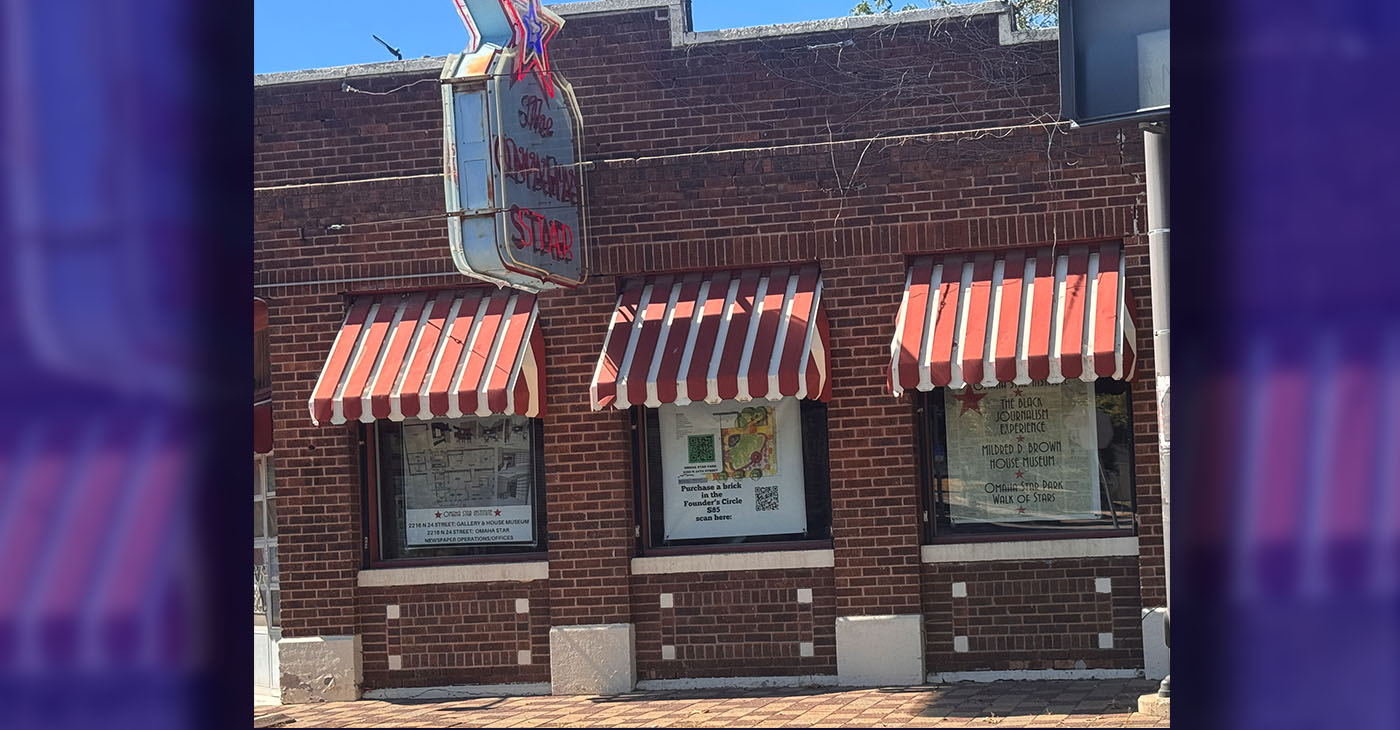#NNPA BlackPress
Terri Sanders Transforms Omaha Star: 87 Years of Black Women Leading Nebraska’s Iconic Newspaper
NNPA NEWSWIRE — Sanders’ plans for the museum are ambitious. She envisions a space that honors Black journalists, features historical exhibits, and preserves the personal quarters of founder Mildred Brown, which remain remarkably intact.

By Stacy M. Brown
NNPA Newswire Senior National Correspondent
@StacyBrownMedia
In North Omaha, the legacy of The Omaha Star lives on, steadfast through decades of change and challenge. Since 1938, Nebraska’s only Black-owned newspaper has been a voice for the community, and now, under the leadership of Terri Sanders, it’s poised to become a national cultural landmark.
“Paper’s been going 87 years. We have never missed a publication day. So, we can’t start with me,” Sanders said in a telephone conversation with NNPA Newswire. The mother of former vice-presidential advisor and MSNBC News journalist Symone D. Sanders-Townsend, Sanders said she remains committed to preserving Omaha’s beacon of Black journalism.
Dr Benjamin F. Chavis, Jr., NNPA President and CEO, Emphasized, “The National Newspaper Publishers Association (NNPA) congratulates Terri Sanders and The Omaha Star for outstanding service and leadership of the Black Press of America. Now there will be a national museum dedicated to the Black Press because of Sanders’ leadership”
The Omaha Star is a member of the NNPA, the trade association representing more than 200 African-American-owned newspapers and media companies across the country. The NNPA is commonly known as the Black Press of America.
Since its inception, The Omaha Star has seen only five publishers, all Black women—a testament to the resilience and continuity that Sanders proudly upholds. She took the reins almost resistantly but with a sense of duty in 2020, right as the pandemic disrupted daily life, presenting her with an immediate trial by fire. “Our ad dollars were hit hard,” Sanders recalled. She said the performing arts had been a core part of the Star’s advertising base, but theaters went dark during the pandemic. “But we kept publishing every two weeks, as we always had,” she declared.
Despite the challenges, Sanders wasted no time updating the paper’s approach. She amplified its digital presence and reinstated beloved features like Family of the Week, a fixture from founder Mildred Brown’s era. “Imagine a paper that’s 85 years old; original subscribers weren’t around anymore. Young people didn’t know what the Omaha Star was,” Sanders explained. By photographing families on their porches and sharing their stories, she re-engaged the community, making the newspaper a familiar part of daily life again.
Her journey to leading the Star began long before she held the title of publisher. Sanders previously led the Red Plains Black History Museum, where she revived its operations after a two-decade closure. “The building was almost condemned, but we used to say, ‘the building is closed, but the museum is open,’” Sanders recalls. Her determination to preserve Black history eventually brought her to the Omaha Star, where she was asked to step in as interim publisher as a board member of the Mildred D. Brown Memorial Study Center. What began as a temporary role quickly became a full-time commitment as Sanders took charge during a pivotal moment for the paper.
In 2023, determined to ensure the Star’s future, Sanders established the Omaha Star Institute and purchased the newspaper outright. She focuses on transforming the paper’s historic headquarters into a world-class journalism museum serving as a national destination for Black history. “I wrote a grant solely for the Omaha Star. They said, ‘Put your dreams on paper and dream big,’” she recalls, having secured $830,000 from the state to jumpstart renovations on the North Omaha building, which is listed on the National Register of Historic Places.
Sanders’ plans for the museum are ambitious. She envisions a space that honors Black journalists, features historical exhibits, and preserves the personal quarters of founder Mildred Brown, which remain remarkably intact. Next door, Sanders is creating the Mildred Brown Strolling Park, which will include a “walk of fame” to honor Black Omaha legends, including media mogul Cathy Hughes and Father John Markoe, who was instrumental in Omaha’s integration efforts. The park will also include a historical marker dedicated to the Omaha DePorres Club, a civil rights group that Father Markoe led in close partnership with the Omaha Star.


Bringing this project to life is a pair of pioneering contractors: Blair-Freeman, the only two Black women contractors in Nebraska, who specialize in historic buildings. Working with Architectural Offices, they’re preserving the building’s historic character while transforming it into a space that will educate and inspire future generations. “It’s symbolic that we’re the only Black women-led publication in Nebraska, and now we’re working with the state’s only two Black women contractors. It’s come full circle,” Sanders said with pride.
As she steers this massive $3 million project, Sanders also reflects on the strength of the Black women who led the Omaha Star before her. “All of the publishers have been Black females. I’m the fifth,” she shared, emphasizing that this legacy of Black female leadership has always been central to the paper’s mission. She’s determined to keep that tradition alive, working with young people to pass on the art and craft of journalism through training programs at the Omaha Star Institute.
For Sanders, the Omaha Star is more than a newspaper—it’s a community anchor, a storyteller, and a testament to Black resilience. “Everybody says, ‘newspapers are dead.’ Not true, they are not. But you have to understand the value of a newspaper,” she said, pushing back against modern cynicism. With the museum expected to open in 2025, Sanders sees a bright future for the Star and a legacy that will resonate far beyond Omaha. “This will be a national treasure, not just for Omaha,” Sanders exclaimed. “We plan to use our office space to teach journalism to a younger generation. We will not be silent; we will tell our stories. That’s the power of the Omaha Star.”
#NNPA BlackPress
LIHEAP Funds Released After Weeks of Delay as States and the District Rush to Protect Households from the Cold
BLACKPRESSUSA NEWSWIRE — The federal government has released $3.6 billion in home heating assistance after a delay that left states preparing for the start of winter without the program’s annual funding.

By Stacy M. Brown
Black Press USA Senior National Correspondent
The federal government has released $3.6 billion in home heating assistance after a delay that left states preparing for the start of winter without the program’s annual funding. The Low-Income Home Energy Assistance Program, known as LIHEAP, helps eligible households pay heating and cooling bills. The release follows a shutdown that stretched 43 days and pushed agencies across the country to warn families of possible disruptions.
State officials in Minnesota, Kansas, New York, and Pennsylvania had already issued alerts that the delay could slow the processing of applications or force families to wait until December for help. In Pennsylvania, more than 300,000 households depend on the program each year. Minnesota officials noted that older adults, young children, and people with disabilities face the highest risk as temperatures fall.
The delay also raised concerns among advocates who track household debt tied to rising utility costs. National Energy Assistance Directors Association Executive Director Mark Wolfe said the funds were “essential and long overdue” and added that high arrearages and increased energy prices have strained families seeking help.
Some states faced additional pressure when other services were affected by the shutdown. According to data reviewed by national energy advocates, roughly 68 percent of LIHEAP households also receive nutrition assistance, and the freeze in multiple programs increased the financial burden on low-income residents. Wolfe said families were placed in “an even more precarious situation than usual” as the shutdown stretched into November.
In Maryland, lawmakers urged the Trump administration to release funds after the state recorded its first cold-related death of the season. The Maryland Department of Health reported that a man in his 30s was found outdoors in Frederick County when temperatures dropped. Last winter, the state documented 75 cold-related deaths, the highest number in five years. Rep Kweisi Mfume joined more than 100 House members calling for immediate federal action and said LIHEAP “is not a luxury” for the 100,000 Maryland households that rely on it. He added that seniors and veterans would be placed at risk if the program remained stalled.
Maryland Gov. Wes Moore used $10.1 million in state funds to keep benefits moving, but noted that states cannot routinely replace federal dollars. His administration said families that rely on medical equipment requiring electricity are particularly vulnerable.
The District of Columbia has already mapped out its FY26 LIHEAP structure in documents filed with the federal government. The District’s plan shows that heating assistance, cooling assistance, weatherization, and year-round crisis assistance operate from October 1 through September 30. The District allocates 50 percent of its LIHEAP funds to heating assistance, 10 percent to cooling, 13 percent to year-round crisis assistance, 15 percent to weatherization, and 10 percent to administrative costs. Two percent is used for services that help residents reduce energy needs, including education on reading utility bills and identifying energy waste.
The District’s plan lists a minimum LIHEAP benefit of $200 and a maximum of $1,800 for both heating and cooling assistance. Crisis benefits are provided separately and may reach up to $500 when needed to resolve an emergency. The plan states that a household is considered in crisis if it has been disconnected from energy service, if heating oil is at 5 percent or less of capacity, or if the household has at least $200 owed after the regular benefit is applied.
The District’s filing notes that LIHEAP staff conduct outreach through community meetings, senior housing sites, Advisory Neighborhood Commissions, social media, posters, and mass mailings. The plan confirms that LIHEAP applicants can apply in person, by mail, by email, or through a mobile-friendly online application and that physically disabled residents may request in-home visits.
As agencies nationwide begin distributing the newly released funds, states continue working through large volumes of applications. Wolfe said LIHEAP administrators “have been notified that the award letters have gone out and the states can begin to draw down the funds.”
#NNPA BlackPress
Seven Steps to Help Your Child Build Meaningful Connections
BLACKPRESSUSA NEWSWIRE — Swinging side by side with a friend on the playground. Sharing chalk over bright, colorful sidewalk drawings. Hiding behind a tree during a spirited game of hide-and-seek. These simple moments between children may seem small, but they matter more than we think

By Niyoka McCoy, Ed.D., Chief Learning Officer, Stride/K12
Swinging side by side with a friend on the playground. Sharing chalk over bright, colorful sidewalk drawings. Hiding behind a tree during a spirited game of hide-and-seek. These simple moments between children may seem small, but they matter more than we think: They lay the foundation for some of life’s most important skills.
Through everyday play, young children begin learning essential social and emotional skills like sharing, resolving conflicts, showing empathy, and managing their emotions. These social skills help shape emotional growth and set kids up for long-term success. Socialization in early childhood isn’t just a “nice-to-have”—it’s essential for development.
Yet today, many young children who haven’t yet started school aren’t getting enough consistent, meaningful interaction with peers. Research shows that there’s a decline in active free play and peer socialization when compared to previous generations.
There are many reasons for this. Children who are home with a parent during the day may spend most of their time with adults, limiting opportunities for peer play. Those in daycare or preschool may have restricted free play, and large classrooms can reduce supervision and social coaching. Some children live in rural areas, are homebound due to illness, have full schedules, or rely on screens to fill their playtime. And for some families, finding other families with young children to connect with isn’t easy.
While these challenges can feel significant, opportunities for connection still exist in every community. Families can take simple steps to help children build friendships, create a sense of belonging, and strengthen social skills. Here are some ideas to get started:
- Storytime sessions at libraries or local bookstores
- Community offerings such as parent-child workshops, art, music, gymnastics, swimming, or sports programs
- Weekly events at children’s museums, which may include art projects, music workshops, or science experiments
- Outdoor exploration, where kids can play with peers
- Local parenting groups that organize playdates and group activities
- Volunteer opportunities where children can participate, such as pet adoption events or packing meals at a food bank
- Classes for kids at local businesses, including hardware, grocery, or craft stores
Some of these community activities are free or low-cost and give kids the chance to build friendships and practice social skills. Parents can also model positive social behavior by interacting with other parents and encouraging their children to play with their peers.
These may seem like small moments of connection, but they can have a powerful impact. Every time your child shares a toy, plays make-believe with peers, or races a friend down the slide, they’re not just playing—they’re learning the skills that build confidence, empathy, and lasting friendships. And it’s good for you, too. Creating intentional opportunities for play also helps you strengthen your own network of parents who can support one another as your children grow together.
#NNPA BlackPress
Seven Steps to Help Your Child Build Meaningful Connections
BLACKPRESSUSA NEWSWIRE — Swinging side by side with a friend on the playground. Sharing chalk over bright, colorful sidewalk drawings. Hiding behind a tree during a spirited game of hide-and-seek. These simple moments between children may seem small, but they matter more than we think

By Niyoka McCoy, Ed.D., Chief Learning Officer, Stride/K12
Swinging side by side with a friend on the playground. Sharing chalk over bright, colorful sidewalk drawings. Hiding behind a tree during a spirited game of hide-and-seek. These simple moments between children may seem small, but they matter more than we think: They lay the foundation for some of life’s most important skills.
Through everyday play, young children begin learning essential social and emotional skills like sharing, resolving conflicts, showing empathy, and managing their emotions. These social skills help shape emotional growth and set kids up for long-term success. Socialization in early childhood isn’t just a “nice-to-have”—it’s essential for development.
Yet today, many young children who haven’t yet started school aren’t getting enough consistent, meaningful interaction with peers. Research shows that there’s a decline in active free play and peer socialization when compared to previous generations.
There are many reasons for this. Children who are home with a parent during the day may spend most of their time with adults, limiting opportunities for peer play. Those in daycare or preschool may have restricted free play, and large classrooms can reduce supervision and social coaching. Some children live in rural areas, are homebound due to illness, have full schedules, or rely on screens to fill their playtime. And for some families, finding other families with young children to connect with isn’t easy.
While these challenges can feel significant, opportunities for connection still exist in every community. Families can take simple steps to help children build friendships, create a sense of belonging, and strengthen social skills. Here are some ideas to get started:
- Storytime sessions at libraries or local bookstores
- Community offerings such as parent-child workshops, art, music, gymnastics, swimming, or sports programs
- Weekly events at children’s museums, which may include art projects, music workshops, or science experiments
- Outdoor exploration, where kids can play with peers
- Local parenting groups that organize playdates and group activities
- Volunteer opportunities where children can participate, such as pet adoption events or packing meals at a food bank
- Classes for kids at local businesses, including hardware, grocery, or craft stores
Some of these community activities are free or low-cost and give kids the chance to build friendships and practice social skills. Parents can also model positive social behavior by interacting with other parents and encouraging their children to play with their peers.
These may seem like small moments of connection, but they can have a powerful impact. Every time your child shares a toy, plays make-believe with peers, or races a friend down the slide, they’re not just playing—they’re learning the skills that build confidence, empathy, and lasting friendships. And it’s good for you, too. Creating intentional opportunities for play also helps you strengthen your own network of parents who can support one another as your children grow together.
-

 Activism3 weeks ago
Activism3 weeks agoOakland Post: Week of November 12 – 18, 2025
-

 Activism4 weeks ago
Activism4 weeks agoOakland Post: Week of November 5 – 11, 2025
-

 Activism2 weeks ago
Activism2 weeks agoIN MEMORIAM: William ‘Bill’ Patterson, 94
-

 Activism3 weeks ago
Activism3 weeks agoHow Charles R. Drew University Navigated More Than $20 Million in Fed Cuts – Still Prioritizing Students and Community Health
-

 #NNPA BlackPress3 weeks ago
#NNPA BlackPress3 weeks agoThe Perfumed Hand of Hypocrisy: Trump Hosted Former Terror Suspect While America Condemns a Muslim Mayor
-

 #NNPA BlackPress3 weeks ago
#NNPA BlackPress3 weeks agoProtecting Pedophiles: The GOP’s Warped Crusade Against Its Own Lies
-

 Bay Area3 weeks ago
Bay Area3 weeks agoNo Justice in the Justice System
-

 #NNPA BlackPress4 weeks ago
#NNPA BlackPress4 weeks ago2026 Subaru Forester Wilderness Review: Everyday SUV With Extra Confidence





















































